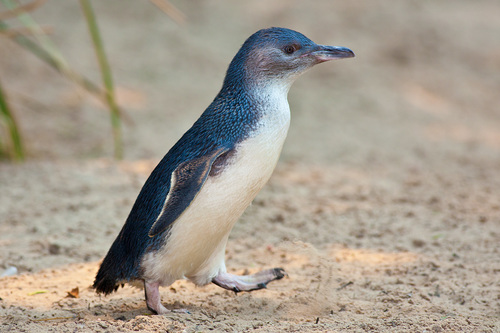
Little Penguin
The Little Penguin (*Eudyptula minor*), also known as the Fairy Penguin, is the smallest species of penguin. These charismatic birds are found along the coastlines of southern Australia and New Zealand. They play a vital role in the marine ecosystem as both predator and prey. Unlike many other penguin species, Little Penguins are known for their relatively small colonies and their habit of returning to their burrows at dusk, a behavior that has become a popular tourist attraction in some areas. Culturally, they are iconic symbols of coastal conservation and ecotourism in their range.
30-33 cm
Length
Not applicable (wings modified into flippers) cm
Wingspan
Least Concern
Conservation Status
Distribution
Little Penguins are found along the southern coastlines of Australia, including Tasmania, and throughout New Zealand, including the Chatham Islands. They are generally non-migratory, staying relatively close to their breeding colonies year-round, although some individuals may disperse more widely.
Lifespan
Average 6-7 years in the wild, up to 25 years in captivity.
Little Penguin's Habitat
Habitat Types
Coastal dunes, Rocky shorelines, Offshore islands
Climate Zones
Temperate, Subantarctic
Adaptations
Little Penguins have dense, waterproof plumage that provides insulation in cold waters. They also possess strong claws for gripping rocks and digging burrows. Their streamlined bodies and flipper-like wings are highly adapted for efficient swimming and diving.
Variations
Several subspecies have been proposed, with variations in size and plumage coloration. For example, the White-flippered Penguin, sometimes considered a separate species (*Eudyptula albosignata*), is found on Banks Peninsula and Motunau Island, New Zealand.
Appearance
Breeding Plumage
Plumage is generally consistent year-round, with a blue-grey upper body and white underparts.
Seasonal Feather Changes
After breeding, penguins undergo a catastrophic molt, replacing all their feathers over a period of about two weeks. During this time, they are not waterproof and must remain on land.
Sex Based Plumage Differences
Males and females have similar plumage.
Notable Features
Smallest penguin species., Distinctive blue-grey plumage., White underparts.
Diet and Feeding
Primary Foods
Small fish (e.g., anchovies, pilchards), Squid, Krill
Foraging Behavior
Little Penguins are pursuit divers, typically foraging within 20 km of the shore and diving to depths of up to 70 meters, although most dives are much shallower. They hunt primarily during the day, returning to their burrows at dusk.
Specializations
Their streamlined bodies and powerful flippers allow for efficient underwater pursuit of prey.
Seasonal Diet Variations
Diet may vary depending on the availability of prey, with some populations relying more on fish or crustaceans at different times of the year.
Behavior
Social Structure
Little Penguins are social, forming breeding colonies that can range from a few dozen to thousands of pairs. They are generally less colonial outside of the breeding season.
Communication
Vocalizations (braying, trumpeting), Visual displays (bowing, preening), Physical contact
Migration
Little Penguins are not migratory in the traditional sense, but individuals may disperse from their breeding colonies after the breeding season.
Territorial or Group Behaviors
They defend a small territory around their burrow entrance. At sea, they may forage in loose groups.
Conservation
Threats
Habitat destruction and degradation, Predation by introduced species (e.g., foxes, cats, dogs), Oil spills and pollution, Climate change (affecting prey availability), Entanglement in fishing gear, Human disturbance
Protection Programs
Habitat restoration and protection, Predator control programs, Monitoring of penguin populations, Establishment of marine protected areas, Rehabilitation of oiled penguins
Local National Laws
Protected under various national and state laws in Australia and New Zealand.
Population Trend
Stable overall, but some local populations are declining.
Population Estimates
Estimated global population of around 469,760 mature individuals.
Interesting Facts
They are the only penguin species with blue plumage.
Their blue-grey coloration provides camouflage in the water, helping them to avoid predators and sneak up on prey.
They can hold their breath for over a minute.
Although typical dives last around 20-30 seconds.
The 'penguin parade' at Phillip Island, Australia, is a major tourist attraction.
Visitors can watch Little Penguins return to their burrows at dusk after a day of fishing.
Faqs about Little Penguin
What is the biggest threat to Little Penguins?
Habitat destruction and predation by introduced species are major threats, along with pollution and climate change.
How deep can Little Penguins dive?
They can dive up to 70 meters, but most dives are much shallower, typically less than 20 meters.
Are Little Penguins endangered?
They are currently classified as Least Concern by the IUCN, but some local populations are facing significant threats.
Copyright @ Nature Style Limited. All Rights Reserved.
 English
English